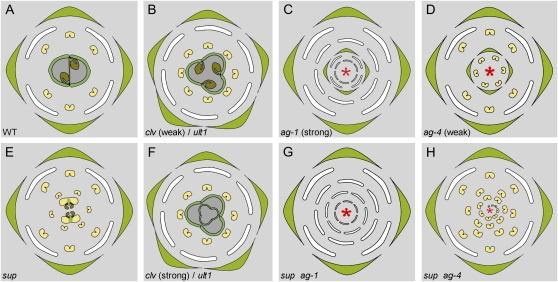Figure 1.
Diagrams of wild-type and mutant Arabidopsis flowers displaying supernumerary organs. A, Wild-type flowers consist of four whorls bearing four sepals, four petals, six stamens, and two fused carpels, respectively. B, Weak clv and ult1 mutant flowers exhibit supernumerary organs contained within the four primary whorls. C, Strong ag-1 mutant flowers are indeterminate, with numerous supernumerary whorls of organs and homeotic transformations of reproductive organs into perianth ones. D, Weak ag-4 mutant flowers are also indeterminate, with numerous supernumerary whorls of stamens and sepals. E, sup mutant flowers display a limited number of supernumerary whorls of stamens and sometimes staminoid carpels in the center. F, Strong clv and some ult1 mutant flowers display supernumerary organs in each primary whorl but also exhibit a weak loss of FM termination, with a limited number of supernumerary whorls within the gynoecium. G, sup ag-1 double mutant flowers display an indefinite number of petals inside the first whorl of sepals. H, sup ag-4 double mutants have fully indeterminate male flowers, with the two inner whorls replaced by an indeterminate number of stamens borne on a spiral. Red asterisks indicate totally indeterminate FMs.

